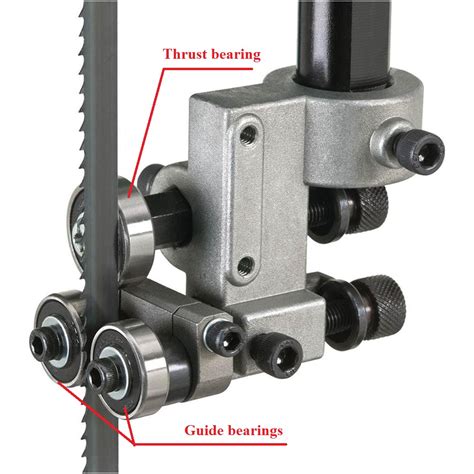Essential Guide to Bandsaw Guide Bearings: Maximizing Performance and Accuracy
Introduction
Bandsaws, indispensable tools in woodworking and metalworking, rely heavily on precise guidance systems to ensure optimal performance and accurate cuts. Among these systems, guide bearings play a pivotal role, minimizing blade deflection and preventing chatter, translating into cleaner cuts and extended blade life. This comprehensive article explores the intricacies of bandsaw guide bearings, providing insights into their types, functions, maintenance tips, and common mistakes to avoid.
Types of Bandsaw Guide Bearings
There are three primary types of bandsaw guide bearings:

1. Ball Bearings
-
Features: Spherical balls held within a steel race, providing low friction and high precision.
-
Advantages: Smooth operation, excellent load capacity, and ease of maintenance.
-
Disadvantages: More expensive than other types and prone to damage from excessive force or contamination.
2. Roller Bearings
-
Features: Cylindrical rollers rotating between inner and outer races, offering high load capacity and rigidity.
-
Advantages: Durable, can withstand heavy loads, and relatively inexpensive.
-
Disadvantages: Noisier than ball bearings and more susceptible to wear and tear under high speeds.
3. Ceramic Bearings
-
Features: Bearings made from non-metallic ceramic materials, exhibiting exceptional hardness and resistance to wear.
-
Advantages: Long lifespan, corrosion-resistant, and can operate under extreme temperatures.
-
Disadvantages: Significantly more expensive than other types and require specialized maintenance.
Function of Bandsaw Guide Bearings
Guide bearings perform crucial functions in bandsaw operation:

-
Precise Blade Control: Bearings act as precision guides, ensuring the blade runs smoothly and accurately, minimizing deflection.
-
Reduced Chatter: They absorb vibrations and prevent blade chatter, resulting in cleaner cuts and extended blade life.
-
Heat Dissipation: Guide bearings help dissipate heat generated by friction, preventing damage to the blade and other components.
-
Wear Reduction: By minimizing blade deflection and chatter, guide bearings reduce premature wear of the blade and surrounding parts.
Maintenance Tips for Bandsaw Guide Bearings
Proper maintenance is essential for optimal performance and longevity of guide bearings:
-
Regular Cleaning: Clean bearings regularly to remove debris and sawdust buildup that can impair operation.
-
Lubrication: Apply a thin layer of lubrication to bearings to reduce friction and prevent wear.
-
Inspection: Periodically inspect bearings for any signs of damage or wear. Replace worn bearings promptly.
-
Adjustment: Ensure proper bearing adjustment to minimize play and prevent excessive loading.
-
Storage: Store bearings in a clean and dry environment when not in use.
Common Mistakes to Avoid
-
Overtightening: Avoid overtightening bearing bolts, as it can damage bearings and cause premature failure.
-
Contamination: Keep bearings clean and free from sawdust or other contaminants that can impair performance.
-
Insufficient Lubrication: Lack of lubrication can lead to premature wear and damage.
-
Incorrect Adjustment: Improper adjustment can result in excessive play or loading, affecting bearing performance.
-
Using Wrong Type of Bearings: Ensure the correct type of bearings is used for your bandsaw, as improper selection can lead to problems.
Step-by-Step Guide to Replacing Bandsaw Guide Bearings
-
Safety First: Unplug the bandsaw and allow it to cool down completely.
-
Remove Old Bearings: Loosen the bearing bolts or set screws and carefully remove the old bearings.
-
Clean and Inspect: Clean the bearing area and inspect for any signs of damage or wear.
-
Insert New Bearings: Place the new bearings into position and hand-tighten the bolts or set screws.
-
Adjust and Test: Adjust the bearings to minimize play while ensuring smooth rotation. Test the bandsaw by running it briefly.
-
Final Tightening: Once satisfied with the adjustment, fully tighten the bearing bolts or set screws.
FAQs
-
How often should I replace bandsaw guide bearings?
- Replace bearings when they exhibit signs of wear or damage, or when performance issues arise.
-
Which type of guide bearings is best for my bandsaw?
- The best type depends on the specific bandsaw model and intended use. Consult the manufacturer's recommendations or seek professional advice.
-
How do I know if my guide bearings need adjustment?
- Signs of misalignment include uneven blade wear, blade deflection, or excessive chatter.
-
Can I lubricate guide bearings with any type of lubricant?
- Use only lubricants specifically designed for bearings, as improper lubricants can damage them.
-
What are the common causes of guide bearing failure?
- Overtightening, contamination, insufficient lubrication, and incorrect adjustment are common reasons for bearing failure.
-
Can I replace guide bearings myself?
- While it is possible to replace guide bearings yourself, it is recommended to consult a qualified technician for proper installation and adjustment.
Conclusion
Bandsaw guide bearings play a critical role in ensuring precision, performance, and longevity of your bandsaw. Understanding their types, functions, and maintenance requirements is essential for maximizing the tool's capabilities. By implementing the tips and avoiding common mistakes outlined in this guide, you can maintain optimal guide bearing performance, leading to cleaner cuts, reduced blade wear, and an enhanced woodworking or metalworking experience.

Call to Action
Maintain your bandsaw guide bearings regularly to ensure precision, performance, and extended blade life. Inspect bearings periodically, lubricate as needed, and adjust to minimize play. If you encounter any issues or are unsure about the proper maintenance procedures, consult a qualified technician for assistance.
